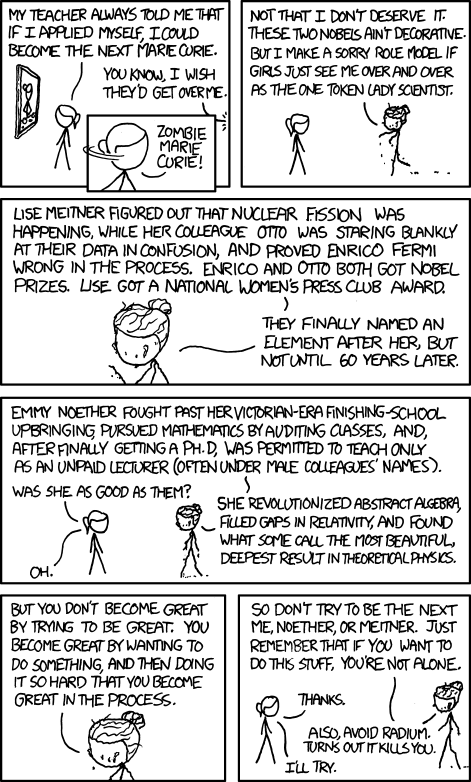In her
Keynote Address to the MIT150 Symposium
Leaders in Science and Engineering: The Women of MIT, Professor Nancy Hopkins presented a wonderful summary of the reasons why there are so few women faculty in science and engineering, especially at the top ranks. She summarized not only her own experience but that of most women faculty members. Had male faculty members experienced the same systematically inequitable treatment, research universities would be under investigation by Congress for discrimination. Unfortunately, as Professor Hopkins points out, the percentage of female Senators is less than the percentage of female faculty members in science and engineering at MIT. That we face broader societal issues is no excuse for ignoring these problems in academia. Universities and other employers that pay attention to equity will outperform ones that do not. Indeed, as a department head I am delighted to see the benefits of gender equity accrue to my institution.
I strongly urge readers to watch Professor Hopkins’ speech at the above link. Here I summarize her analysis of the obstacles overcome and those remaining before women face a level playing field in academia.
Prior to the Civil Rights Act of 1964 and the implementation of affirmative action regulations in 1971, universities regularly barred women from the faculty. Such remarkable scientists as Mildred Dresselhaus, Cecilia Payne-Gaposchkin, and Barbara McClintock all faced this now-illegal discrimination. But the legal system and the women’s movement of the 1970s did not eliminate all forms of discrimination.
Sexual harassment was, and remains, a serious problem. Professor Hopkins told her own stunning story. Unfortunately, I know from service on the Committee on the Status of Women in Astronomy that sexual harassment is not fully eliminated even today. Astonishingly it is present in some highly ranked programs. Today it is possible to gain remedy in the courts; however the effort required is onerous. Universities and other organizations should not wait for lawsuits and should not merely proclaim policy, but should investigate and discipline harassers. The American Astronomical Society has an
anti-harassment policy that is laudably clear on this point.
A second obstacle has been the lack of mentoring. Faculty members are not born; they are made. Professional athletes have trainers; corporate executives have coaches; faculty members also benefit from guidance beyond the research apprenticeship of graduate school and postdoctoral studies. This is especially important for faculty in underrepresented groups who have few role models. I’m proud to be at a university whose women took the lead in faculty mentoring 20 years ago with the
MIT Mentoring Booklet. Mentoring performance is now evaluated as part of our faculty promotion and tenure review. In my department it is a component of the annual salary review for all faculty members. Still, mentoring is not universally valued and remains low-hanging fruit for institutional advantage. Universities and other employers that mentor their employees will outperform ones that do not.
A third barrier is the work-family dilemma: how to be a parent (or otherwise have a personal life) and a faculty member at a research-intensive university. It is still falsely presented as “a women’s choice” by some: whether to have children or to become a faculty member. Universities must do more to lower that barrier because we need to train and advance the best available young people, most of whom want to have children. Simply arranging for a campus daycare center is far from adequate, as the years-long waiting lines and lack of affordable child care for graduate students and postdocs makes clear. This is a big issue requiring far more attention.
After all the efforts made to overcome the first three barriers, there remain two obstinate challenges: unconscious bias and marginalization. Unconscious bias arises when both men and women undervalue the contributions of women. Every year I read reference letters – even in tenure cases – where a woman is described as “nice and personable” (or compared solely with women!) instead of being judged on her scientific contributions. Every year women are overlooked for awards because nominators tend to think of people like themselves and they undervalue the contributions of those unlike themselves. Even women tend to undervalue other women. These biases are measurable and can be corrected (see, e.g., Project Implicit), but only if we are made aware of them.
The problem of marginalization is, sadly, an illustration that even conscious bias has not been entirely eliminated. Women at all levels continue to receive comments from men that “you’re here because of affirmative action.” Recently I heard this from senior faculty at a highly-ranked physics department. I hear it all too often from female graduate students and even undergraduates. I have been in department leadership for a decade and never once during this time have I seen anyone admitted or hired because of affirmative action. Such claims are false – as Professor Hopkins showed, a higher percentage of female than male full professors of science at MIT are members of the National Academies. Marginalization of
any group must stop; to the extent that it creates a hostile work environment, it may even be illegal.
Professor Hopkins then described the efforts MIT made to correct these problems and the remarkable progress resulting from the changes. This is very good news. The improvements in the university for everyone – and especially for women – have made her (and me) optimistic that full equity in research universities may come in our lifetimes.
